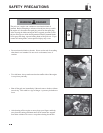
2121
2121
21
• WOUND DRESSINGS - Wound dressings have been shown to
interfere with the natural development of callus tissues that eventu-
ally close the pruning wound. In some cases, wound dressings can
even harbor disease organisms much like what occurs when a Band-
Aid is left on a skin cut too long. It is far more important to make the
cut smooth, outside of the collar and allow the wound to dry.
If a wound dressing is desired for aesthetic purposes, use a very thin
coat, just enough to darken the wound area. The best are the aerosol
sprays of water-emulsified asphalt sold in garden centers. Do not use
oil-based paints, thick tars or other materials containing petroleum
solvents.
• MAINTAIN TREE HEALTH - The key to good wound closure
following pruning is to maintain a healthy tree through proper
watering, fertilizer application and pest control. Trees under stress
from drought, over-watering, pest attack, lawn mower and other
mechanical damage, and poor nutrition cannot successfully fight off
invasion of disease.
For larger branches, a three-step approach is recommended to avoid
tearing or ripping the tree’s bark.
1. The first cut should be a shallow notch, made on the underside of
the branch several inches from the branch collar.
2. The second cut, which goes entirely through the branch, is made
just outside the first cut.
3. The remaining stub is then cut just outside the branch collar.
Always prune branches to the point of origin. Remove small twigs where
they emerge from small branches and remove large branches at the
juncture with a larger branch or at the trunk.
Be sure to remove all dead or damaged branches first, followed by
branches that interfere with each other or those that form weak angles.
Retain the strongest, best placed branches; remove the weaker ones.
SHRUBS
Many shrubs have growth patterns similar to trees, but on a smaller
scale. They should be pruned like trees, with these considerations:
A. Prime pruning periods for deciduous shrubs depend on the
purposes for which the shrubs are grown. For example, shrubs
whose foliage is the greatest attribute can be pruned anytime
during the winter to early spring. Shrubs whose spring flowers are
their best feature are best pruned immediately after the blooming
period. And shrubs grown primarily for their summer blossoms
can be pruned during the winter.
B. Up to one-third of a deciduous shrub’s growth can be removed at
any one time. By selectively removing the oldest, heaviest
branches at ground level, you automatically reduce its height.
Some of the most sturdy hedge plants can be cut back further, to
within six or eight inches of the ground during late winter. These
plants will shoot up new growth in the spring, thickening a young
hedge or rejuvenating an old one.
PRUNING: TIMING AND TECHNIQUE


















